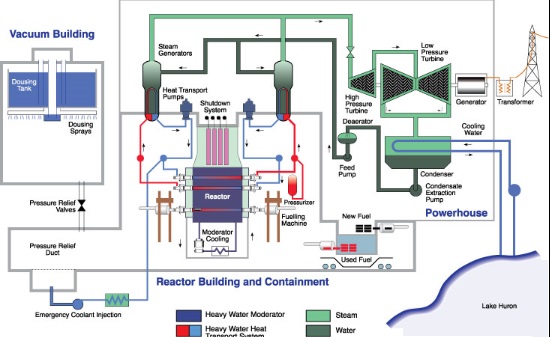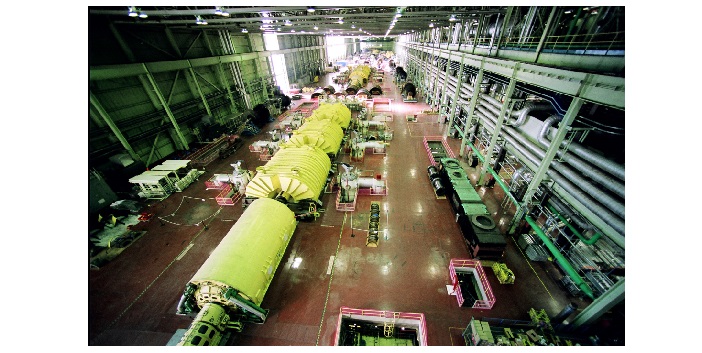Ontario has updated its contract with Bruce Power and will proceed with the refurbishment of six nuclear units at the Tiverton-based nuclear generation station.
Nuclear refurbishment will boost economic activity across Ontario, create jobs, ensure savings for ratepayers and secure a clean supply of reliable electricity. The Bruce Power refurbishment project will make up to 23,000 jobs possible and generate about $6.3 billion in annual economic benefits in communities throughout the province. Ontario is home to a globally recognized CANDU nuclear supply chain with more than 180 companies employing thousands of highly skilled workers.

The government was further able to optimize the nuclear refurbishment schedule in order to maximize the value of existing nuclear units. The revised timeline will mean construction commences in 2020, rather than the previously estimated start date of 2016.
Accordingly, the updated agreement has achieved $1.7 billion in savings for electricity customers when compared to the forecast in the 2013 Long-Term Energy Plan (2013 LTEP). This means a reduction in forecast household electricity bills by about $66 each year over the next decade. The contract also protects the interests of electricity consumers by ensuring Bruce Power assumes full risk for any potential cost overruns or delays.
Key aspects of the updated agreement include:
- Securing 6,300 MW of emissions-free, baseload generating capacity while deferring major project work to 2020, to maximize value of the units
- Bruce Power would invest approximately $13 billion of its own funds and agrees to take full risk of cost overruns on refurbishments of the six nuclear units
- Initial price for Bruce Power’s generation set at $65.73/MWh starting January 1, 2016. The average price over the life of the contract is estimated to be $77/MWh, or 7.7 cents per kilowatt hour (kWh).
- Both prices are within the range assumed in the 2013 LTEP for refurbished nuclear energy and are lower than the average price of electricity generation in Ontario, which in 2015 was $83/MWh
- Definitive contract off-ramps that allow the government to assess Bruce Power’s cost estimates for each reactor prior to its refurbishment and stop the refurbishment if the estimated cost exceeds a pre-defined amount
The province is achieving balance by contracting affordable, stable and reliable generation for residents and businesses while securing investments that will be a key source of local job creation and economic growth.
Securing clean, reliable baseload power for decades to come is part of the government’s plan to build Ontario up. The four-part plan is includes investing in people’s talents and skills, making the largest investment in public infrastructure in Ontario’s history, creating a dynamic, innovative environment where business thrives and building a secure retirement savings plan.
“This agreement makes 23,000 jobs possible and supports an estimated $6.3 billion in annual, local economic development. Our updated agreement with Bruce Power secures 6,300 MW of emission-free, low-cost electricity supply. These actions will save the electricity system $1.7 billion and provide important relief for electricity consumers.”
— Bob Chiarelli, Minister of Energy
““Today is a major milestone in the history of Bruce Power as we build on our existing agreement with the province and extensive experience to enter the next phase of our site development. This provides us the opportunity to secure our long-term role as a supplier of low-cost electricity by demonstrating we can successfully deliver this program incrementally.”
— Duncan Hawthorne, President and CEO, Bruce Power
QUICK FACTS
- Following the release of the 2013 LTEP, the amended BPRIA was negotiated over two years by the Independent Electricity System Operator (IESO).
- The Bruce nuclear site is the world’s largest operating nuclear facility. Since it was formed in 2001, Bruce Power and its industry partners have engineered and developed first-of-a-kind technologies that helped return four dormant nuclear units to service.
- Nuclear energy plays a fundamental role in Ontario’s electricity system. It provides over half of Ontario’s annual generation, meeting most of Ontario’s baseload requirements.
LEARN MORE
- Learn about Bruce Power
- Read Affordable Power. Jobs & Growth. By the Numbers: Securing both affordable power
- Read Ontario’s 2013 Long-Term Energy Plan
- Lean more about the amended BPRIA
Supplemental- The CANDU Bruce Nuclear Generating Station on Lake Huron is the largest nuclear power plant in the world.


UPDATE———-January 11, 2016
Ontario Moving Forward with Nuclear Refurbishment at Darlington and Pursuing Continued Operations at Pickering to 2024
Projects will Boost Economic Activity, Create Jobs and Help Fight Climate Change
Ontario is moving forward with nuclear refurbishment at Darlington Generating Station, securing 3,500 megawatts of affordable, reliable, and emission free power.
Nuclear refurbishment at Darlington will contribute $15 billion to Ontario’s gross domestic product (GDP) throughout the project and create up to 11,800 jobs annually. The refurbishment of all four units is expected to involve about 30 million hours of work over 10 years and will support Ontario’s globally recognized CANDU nuclear supply chain, with more than 180 companies employing thousands of highly skilled workers.
Ontario Power Generation (OPG) is on track to begin refurbishment of the first unit at Darlington in October 2016. To best protect Ontario ratepayers and ensure OPG delivers refurbishment on-time and on-budget, the government has established off-ramps that require OPG to obtain government approval prior to proceeding with each of the remaining unit refurbishments. The budget for the project is $12.8 billion, about $1.2 billion less than originally projected by OPG, and all four units are scheduled for completion by 2026.
The province has also approved OPG’s plan to pursue continued operation of the Pickering Generating Station beyond 2020 up to 2024, which would protect 4,500 jobs across the Durham region, avoid 8 million tonnes of greenhouse gas emissions, and save Ontario electricity consumers up to $600 million. OPG will engage with the Canadian Nuclear Safety Commission and the Ontario Energy Board to seek approvals required for the continued operation of Pickering Generating Station.
Securing clean, reliable power for decades to come is part of the government’s plan to build Ontario up. The four-part plan includes investing in people’s talents and skills, making the largest investment in public infrastructure in Ontario’s history, creating a dynamic, innovative environment where business thrives and building a secure retirement savings plan.
QUOTES
“Proceeding with the refurbishment at Darlington will ensure that nuclear continues to be Ontario’s single largest source of power. The Darlington refurbishment project will create up to 11,800 jobs annually and contribute $15 billion to Ontario’s GDP. Continuing operations at Pickering will protect 4,500 jobs across the Durham region, provide emissions-free electricity, and save Ontario electricity consumers up to $600 million.”
— Bob Chiarelli, Minister of Energy
“Refurbishing Darlington is an investment in Ontario. It’s good for the customers, it’s good for the economy and it’s good for the environment. We’re confident we have done the work and have the people in place to deliver this project safely, on schedule and on budget.”
— Jeffrey Lyash, President and CEO, Ontario Power Generation
“With these investments, nuclear will continue its role in ensuring Ontarians have enough power when and where they need it. The plan to refurbish the Darlington nuclear units and to keep Pickering in operation longer during the refurbishment period is a cost effective way to meet our future power needs.”
— Bruce Campbell, President and CEO, Independent Electricity System Operator
QUICK FACTS
§ Nuclear energy plays a fundamental role in Ontario’s electricity system. Ontario’s nuclear fleet currently supplies enough power to meet about 60 per cent of Ontario’s daily electricity needs, and is our largest source of reliable, affordable power.
§ OPG electricity rates are regulated by the Ontario Energy Board (OEB). All costs for the Darlington refurbishment will be subject to review and approval by the OEB through a public and transparent process to ensure they are prudently incurred. The average cost of power from Darlington nuclear units post-refurbishment is estimated to range between $72/MWh and $81 MWh, or 7 and 8 cents per kilowatt hour.
§ The average cost of power from Darlington after refurbishment is within the range assumed in the 2013 Long-Term Energy Plan for refurbished nuclear energy and lower than the average price of electricity generation in Ontario, which in 2015 was $92/MWh.
§ The Pickering Generating Station employs about 4,500 people and is the largest employer in Durham Region.
§ Continuing operations at Pickering Generating Station will avoid 8 million tonnes of greenhouse gas emissions, which is the equivalent to taking 490,000 cars off Ontario roads.
LEARN MORE visit http://www.ontario.ca
§ Learn about OPG’s Darlington Refurbishment Project
§ Read the Conference Board of Canada’s report on the economic impact of the Darlington Refurbishment
§ Read Ontario’s 2013 Long-Term Energy Plan